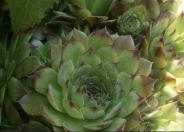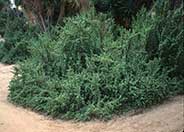
Common name:Hens and chicks, houseleek, roof ho
Botanical name:Sempervivum tectorum
Sempervivum tectorum is a low-growing evergreen succulent that looks a little like rubbery roses with thick, fleshy pads arranged in rosettes. The leaves are usually pointed and some have purple tips or they may grow in shades of red. They are considered alpine or rock garden plants, because of their hardiness and drought resistance. The original hen rosette produces tiny rosette offsets known as the chicks. They are slow-growing plants, and they remain evergreen throughout the year, even in cold climates. Mature plants produce an odd-looking thick flower stalk with star-shaped flowers at the tip of mauve-pink or red. These are not tall plants, except when they stretch out to flower. The flower stalk extends 8 to 12 inches before flowering, then reduces in size once the plant blooms and the mother plant dies. Hens and chicks are not grown for their flowers, but when they do bloom, it is usually during the summer. Plant them in late spring, when there's no longer a chance of frost and it's still not too hot outside. Planting a large patch, using them along edges, or mixing them in a container garden will help them stand out. Another option is to mix hens and chicks with creeping sedum which can make a lawn alternative where there is no foot traffic. If you have a rock garden or rock wall, you have the perfect environment for growing hens and chicks. Tuck them into the crevices or let them drape over a rock wall. Stone provides the perfect balance of drainage, radiant heat, and root protection. Hens and chicks will spread by underground roots. During the growing season, expect each plant to multiply itself by at least four, by producing little offset plantlets all around the perimeter of the hen. These chicks can be snapped off and replanted elsewhere at any time. Once established, the maintenance of hens and chicks is minimal. You’ll need to remove the old hens, after they flower, and divide chicks as needed. They are tough plants that survive just about any condition, even frost and cold. Hens and chicks prefer a spot in full sun but will appreciate some afternoon shade if planted in extremely hot climates. Hens and chicks, as with most succulents, need excellent drainage. Poor, sandy soil would be just fine. You could work some peat into heavier soil, to lighten it and improve drainage. Soil pH should be in the neutral range, 6.6 to 7.5. Except in extremely hot, dry situations, you won’t need to give this plant any supplemental water. They prefer an average climate between 65 and 75 degrees Fahrenheit. If temperatures drop too low, they will not necessarily die off but will stop growing and go into a semi-dormant state. No fertilizer is needed.

Common name:Elephant's Food, Elephant Bush
Botanical name:Portulacaria afra
Interesting succulent with irregular growth habit. Depending on pruning and cold, elephant's food can be grown as a groundcover or shrub to 12' tall and wide. Plants work very well in containers, and can be used indoors or outdoors. Drought tolerant, but needs some protection from frost. Does best with some shade in most arid climates, otherwise tolerates full sun. Native to South Africa.

Common name:Carpet Echeveria
Botanical name:Echeveria agavoides
This attractive succulent has fleshy leaves that form rosettes, with an overall diameter of 12". Foliage is apple green color with a terminal spine and reddish margins. Flower stalks rise up from the center in spring and summer with tiny red and yellow flowers. This plant tolerates full to part sun and needs well draining, dry, well draining, sandy or rocky soil. Beautiful in containers and rock gardens. Great for a Southwest or desert themed garden.

Common name:Echeveria hybrids
Botanical name:Echeveria hybrids
Echeveria hybrids are succulents that has numerous cultivars. This is not a tropical plant. Most have thick, wide leaves and some have ruffled, frilly leaves. Foliage is in rosettes, some tightly coiled and others, loose. They do well in coastal areas and need afternoon shade in warm, inland areas. They like to grow in containers and among rocks and small crevices. They need well draining soil. Leaves come in different colors, thus folks grow them for the foliage more than the flowers which are typically on a thin stalk. Most have offsets, thus easy to propagate. They spread but are typically not invasive.
Designer:
Photographer: Vicki Anderson
Incorporate compost 6" into your soil to retain water, reduce compaction, feed earthworms, and provide valuable nutrients to your plants.
Develop healthy soil for plants that are vigorous and naturally pest-resistant.